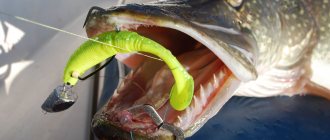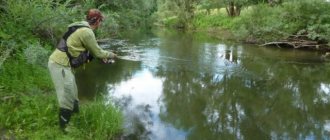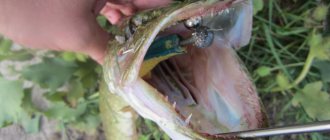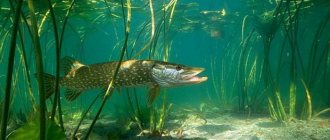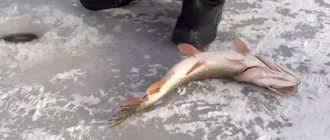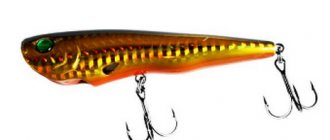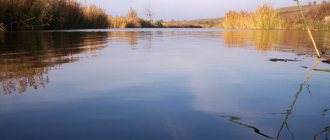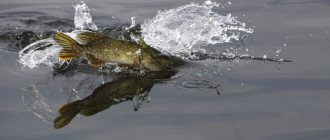Where to catch pike or perch using a spinning rod
To choose a spinning rod suitable for catching pike and perch, it is important to take into account the conditions in which you will be fishing and the expected size of the trophies. These predators are found in lakes, reservoirs and rivers. In the coastal zone, at depths of up to 3-4 m, predominantly small fish are found. For fishing in such places, light baits and spinning rods are used, which allow you to work with them comfortably. To look for perch and pike in the coastal zone you need to:
- in the bays;
- in thickets of grass and at their borders;
- in snags;
- on the edges;
- at the confluence of streams.
Large fish prefer to stay in the depths away from the shore. To fish here, you will need bait weighing up to 50 g and appropriate spinning rods. Suitable places for fishing would be:
- eyebrows;
- pits;
- underwater streamers;
- navels - rounded elevations at the bottom;
- snags.
The toothy predator is also often found in small ponds that become heavily overgrown in the summer - toad ponds. The main thing is to know how to fish in such conditions. It is necessary to use non-meshing installations and short wiring through free areas of water.
Differences in catching predatory and peaceful fish using a spinning rod
Peaceful fish caught with spinning rods prefer small baits. Unlike pike and perch, due to the structure of its mouth, it is not capable of swallowing large prey. Therefore, to catch it you need spinning rods that allow you to cast and retrieve small spinners, silicone baits and wobblers.
Otherwise, there is no difference between catching predatory and peaceful fish using a spinning rod. When hunting with this gear for representatives of the underwater world, which are more often caught on a float rod or donk, the same techniques and techniques are used as when fishing for a predator.
Catching perch with live bait using float tackle
In late autumn, you can often encounter a very weak bite of various types of fish, but the ubiquitous perch is active until the freeze-up, offering interesting fishing for small fish. Successful fishing begins with the extraction of this particular bait. As experienced fishermen say: “I caught a fry, I caught a perch.”
Live bait is usually caught with roach in various shallow areas of the reservoir, mainly near islands of grass where the predator's favorite roach likes to stay, and small roach also settles there. A small crucian carp is also suitable, which can be easily collected in small ditches and quarries using the same small fish. In cold water it is very tenacious, agile on the hook, which is what perch likes so much, which, unlike pike, prefers nimble live bait.
Perch fishing tackle
If you go for whitefish mostly with fly tackle, then for perch a match reel fishing rod 4-4.5 is better suited, because a school of perch usually does not stand still, actively moves, and you have to constantly change the distance and direction of casting - further, closer, to the left, more to the right, and also move from point to point regularly, radically changing places.
A small inertia-free fishing line also helps, a 0.22mm fishing line, a 0.16-0.20 leash, a hook - the size of the fry and the predator being caught. Float with a lifting capacity of 4-10g, the specific option depending on the casting distance and wind strength. In general, classic perch fishing with live bait, often very productive, but, unfortunately, labor intensive. And this is due to the fact that large humpback whales prefer to stay far from the shore, retreating to pits in late autumn, along with the fry. In this case, a boat can help out.
Skilled perch fishers practice boat fishing for fry using the same float tackle, but not by casting, but by rowing. The rig is lowered near the boat, folding back the line handle, they swim 10-12 meters from the float, close the handle and slowly row. If there is wind, and it coincides with a direction suitable for fishing, then they take it as an ally and simply drift. If the boat is driving too fast, then you can slow down with the oars, trying to move the rig slowly so that the bait does not rise too high from the bottom. Although it happens that even in the bitter cold of pre-winter, perches are caught in half-water, and if there are no bites at the bottom, it is important to check different water horizons.
After the first bite, it is important to hook sharply and immediately drop the anchor, because this is not a pike path, but perch is a schooling fish. Having caught the first fish, it is important to immediately throw the equipment at the bite point; usually striped fish are caught in batches. You should fish as quickly as possible, as seasoned spinning fishers do when they run into a dense school of perch. If the boat was drifting in a decent wind, then you have to cast against the wind, for this reason the working descent from the boat to the float is initially made no more than 12 m , in order to then cast over the same short distance. Although the perch bite at one point does not last long, as a rule, 3-5 fish are caught, and everything dies out. In this case, you have to continue active searches for schools of perch.
It happens that in the midst of fishing, when a perch is found, the supply of live bait runs out. For such force majeure cases, experienced fishermen try to keep a couple of winter fishing rods in stock for vertical lures, and then you can continue to successfully catch striped fish by equipping the fishing rod with a small balancer or a vertical lure. But the fry still works more reliably.
Spinning rod length
For hunting pike and perch, spinning rods ranging in size from 1.8 to 2.7 m are used. Long spinning rods are suitable for coastal fishing. They allow you to make long casts, reaching fish standing at a distance.
When fishing with a long spinning rod, it is convenient to maneuver the equipment, circling the islands of grass located in the water.
Short spinning rods are used when fishing from boats. A short spinning rod is convenient when fishing from a boat, and long casts are not required here. Another area of application for short spinning rods is fishing from a shore covered with forest or bushes. With a short rod it is convenient to move among the thickets and make casts from under overhanging branches.
What gear to use when fishing with the “Moscow” rig
It is generally accepted that this fishing method was invented and implemented by Moscow fishermen, which is why this equipment is often called “Moscow” . When the fish is active, it can be caught without any problems using a classic “jigging” rig, but days when fish are actively biting are quite rare. When the fish behaves passively and refuses to respond to the most seemingly catchy “jig” baits, the use of a retractable leash is especially relevant.
Since the length of the leash can reach one and a half meters, for the convenience of casting and the safety of the fisherman, the spinning rod should be no shorter than 2.7 meters, and preferably 3-3.5 meters. Since the rod is quite long, it is preferable that it be made of modern composite materials with minimal weight. This will allow the angler not to get tired throughout the fishing. The rod structure should be selected based on the type of fish that is intended to be caught.
For fishing with “Moscow” equipment, fairly large reels measuring 3500-4500 are used. This is necessary for:
- optimal tackle balance,
- longer casting,
- forcefully playing fish.
This fishing requires the mandatory use of a braided cord, which, due to its zero elongation, will allow you to better control the bait and feel all the fish bites.
For this fishing method, a regular “Cheburashka” sinker can be used, but it is better to use a pear-shaped weight, as it is less susceptible to snagging on snags and has better aerodynamics. The weight of the sinker is not as important as when fishing with a traditional jig, since the weight is located at a considerable distance from the bait and does not affect its performance. When choosing the mass of the cargo, the strength of the current in a given section of the reservoir and how far from the shore or boat the predator’s parking areas are are taken into account.
Spinning test
Test - the recommended weight range of the baits used. According to this parameter, fishing rods can be divided into 5 classes.
| Ultralight spinning rods | up to 7 g |
| Light spinning rods | 5−15 g |
| Medium spinning rods | 10−30 g |
| Heavy spinning rods | 20−50 g |
| Super heavy spinning rod | more than 50 g |
For fishing for pike and perch, equipment weighing from 3 to 20 g is most often used. Spinning rod test for pike - from 5 to 40 g, depending on the expected size of the trophy.
How to choose a balancer for winter fishing
Choosing the right balancer for winter fishing is 50% success and there are several criteria by which one or another bait is preferred. There is no difficulty here.
When choosing bait, consider:
- the expected size of the trophy being hunted (small perch need one balancer, pike perch from 1 kg and above need another);
- depth at the fishing point;
- is there a current in the reservoir;
- bait wiring height;
- time of day when fishing takes place (day/night) and light level;
- the gear used.
There is no point in catching a small predator with a large balancer, especially since such bait will simply scare it away. If there are both small perch and trophy pike in the reservoir, you have to vary the bait to choose the most suitable one.
But again, it is important to understand that with a small bait you will be able to catch a trophy pike, but the opposite is unlikely.
On the other hand, a large balancer fishes a large area under the hole, and this is important when catching low-active fish. Therefore, a reasonable compromise is needed and the size of the bait used is determined by the average size of the predator in the reservoir, as well as the area of the fished area.
The depth at the point where the hole is drilled and the presence of current also play a role if fishing is carried out on a river. The angler needs to understand how to properly fish with a balance beam so that the bait behaves naturally and moves in a horizontal plane at a given depth. Wiring in the bottom layer and at a depth of 4–5 meters or more requires the selection of heavy balancers weighing more than 6 grams. A heavy bait is also chosen when fishing in the current, because a light balancer will be carried away by the flow of water from the chosen place.
- when fishing at a depth of 1 to 3 meters (and there is no current), balancers 2–5 cm long are used. This bait is intended for small fish, but biting trophies, especially during thaw periods, happens often;
- for medium-sized fish, at a depth of up to 5 meters, balancers with a length of 5 to 8 cm are used. These are the favorite baits and depths for pike perch and perch;
- To catch pike in deep water (including in the current), heavy baits up to 9 cm long are used.
The shape of the balancer is chosen depending on what kind of predator will be in the catch; “pot-bellied” artificial fish work better for perch, but narrow-bodied ones work better for pike perch.
Whatever they say, the price of baits also plays a role in their choice, especially considering that the fisherman has a lot of them in his box. Conventionally, balancers are divided into cheap ones, made in China, or home-grown craftsmen, and expensive ones, from popular global manufacturers.
Here, each angler has his own arguments when choosing (after all, not everyone has a budget sufficient to buy 2-3 dozen branded lures), but do not forget that it is better to buy one catchable balancer from Lucky John or Rapala than 3– 5 Chinese that won't do any good.
Chinese products do not differ in quality, their stabilizers quickly fall off (and they have to be glued), and the quality of the hooks leaves much to be desired. But the main thing is that in water such baits do not show the results that are expected from them.
For experienced fishermen, up to a dozen good quality artificial fish are enough to fish for the entire winter season.
Don’t forget to check the sharpness of the hooks and tees on the balancer and if they are dull, sharpen or change them.
Spinning rod structure
Three types of spinning rods are used for fishing for pike and perch:
- medium-fast action;
- fast formation;
- super-fast build.
The latter are characterized by maximum rigidity. They allow precise twitching of wobblers and provide the best sensitivity when fishing with jigs. Spinning rods of medium-fast action, in turn, due to their softness, tie up the fish, absorbing its jerks and preventing it from getting off the hook. They are well suited for hunting perch - this fish has weak lips that can tear when fishing.
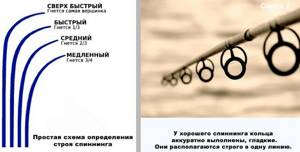
Medium-fast spinning rods are used mainly for fishing that requires uniform retrieval. Fast action rods are a kind of golden mean. Such spinning rods are extremely versatile.
Coil selection
For hunting pike and perch, spinning reels are more often used. Their main advantages:
- ease of use;
- the ability to throw light equipment over long distances;
- a wide selection of affordable models, from which every spinning player will choose the appropriate option for himself.
The size of the reel for pike fishing is selected in such a way that it harmoniously combines with the spinning rod. The spool must hold at least 130 meters of main line of the required diameter.
Multiplier reels are also used. These models:
- have high traction characteristics;
- are highly durable;
- do not twist the line during wiring;
- provide maximum sensitivity of the spinning rod.
Multiplier reels are suitable for catching large fish with large baits that create strong resistance when retrieving. They are often used to hunt trophy toothy predators.
fishing line
Monofilament or braid is used as the main line. Transparent monofilament is less visible in water. It stretches well and thanks to this it absorbs the jerks of the fish when playing. Another advantage is its affordable price. But monofilament has significant disadvantages:
- due to its stretchability, it does not provide sensitivity to the equipment, so when fishing with it it is difficult to control the bait during retrieving;
- monofilament is superior in diameter to braided line of equal breaking load, so when fishing with it it is difficult to make long casts and to properly place the bait.
The main area of use of monofilament is catching perch with spinners and other baits that require uniform retrieval at close range. Vision plays an important role in perch hunting, so fishing with monofilament is more successful. The monofilament absorbs the jerks of the fish, preventing the weak lips of the perch from tearing.
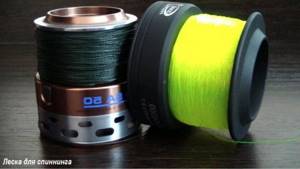
But in most cases it is better to use braid. Its advantages:
- low elongation, thanks to which the cord provides maximum sensitivity of the spinning rod;
- small diameter with a high breaking load - due to this, the braid allows long casts and provides minimal resistance to water flow, making it convenient to retrieve baits when fishing on the river at great depths.
Braid is 10 times more expensive than monofilament, but it makes fishing comfortable and productive. A coil of cord will last for more than one season, so you shouldn’t waste money on buying it. Due to its low elongation, braiding almost does not absorb the jerks of the fish, so to fish with it you need to use a high-quality reel with a correctly adjusted drag.
To make leashes, use monofilament or fluorocarbon. The latter is a new type of fishing line. The refractive index of light in fluorocarbon is close to that of water, so such a thread is almost invisible in water. Another advantage is its rigidity. Fluorocarbon is very resistant to abrasion from rocks and shell rock lying on the bottom. A mandatory element of equipment for catching toothy fish is a metal leash, which protects the fishing line from being bitten.
Methods for installing a diverter leash on a perch
Perch is perfectly caught using the “Moscow” rig throughout the entire period of open water. For catching perch and other predatory fish, there are three main options for installing the “Moscow” equipment:
- using a triple swivel,
- with a sliding sinker,
- loop installation.
Even a novice angler can easily make any of these equipment options with his own hands.
To make the first option, it is enough to have a triple swivel and several meters of fishing line of different diameters. The main cord is tied to one of the side fastenings of the swivel, and a leash made of fishing line with a thickness of 0.12-0.35 mm and a length of 60 centimeters to one and a half meters is attached to the other. A sinker on a fishing line with a diameter of 0.25-0.45 mm and a length of 15 centimeters must be tied to the lower fastening of the swivel. A hook with bait is attached to the leash using a carabiner or knot.
You should immediately make sure that the equipment is always knitted from fluorocarbon fishing line, since it is more resistant to abrasive loads and, accordingly, is less damaged when in contact with underwater rocks and shell rock.
The second option is the easiest way to install a diverter leash. Installation using a sliding sinker requires an “olive” weight, through which a fishing line 60 centimeters long and 0.30-0.45 mm thick is threaded. One end of the fishing line is attached to the main braided cord; a swivel is attached to the other end, which will serve as a limiter for the sinker. A leash with a hook is attached to the loose fastening of the swivel.
It is very important to note which knot should be used to tie the fishing line to the braided cord. This should be a counter knot or a carrot knot. If you tie the fishing line and the “braid” with a regular “clinch” knot, then when casting forcefully or forcefully playing the fish, the thin cord will cut the fishing line.
The third option is also very easy to make. In the middle of a piece of fishing line 0.20-0.25 mm thick, 70 centimeters long, a loop is knitted, the length of which is 15-20 centimeters. Two small loops are also knitted on both sides of the segment. A sinker is attached to the large loop, and a cord and leash are attached to the small loops.
To catch perch, it is better to use light rods with a test weight of up to 20 grams, a reel of size 3500 and “braid” with a diameter of 0.10 mm. The diameter of the fluorocarbon leader should be 0.12−0.16 mm with a length of 60−80 centimeters. A spinning rod for perch fishing should have a fairly soft action. The fact is that the lips of a perch are very weak, and when using hard rods, frequent fish escapes cannot be avoided.
Perch should be caught with small hooks No. 8−4 , on which small silicone baits can be attached:
- twister,
- crustacean,
- leech.
If the perch bite is weak, it is better to use “edible” rubber as bait, which the perch bites on more readily.
Choosing bait for perch
For catching perch, mainly light and compact baits are used.
- Spinner spoons in sizes 00 to 3 are suitable for shallow water fishing. Weighted spinners are used for fishing at depth.
- Silicone baits are suitable for fishing both in shallow coastal waters and in deep water. More often, twisters with a length of 3 to 7 cm are used. Vibrating tails and silicone crustaceans can also be successfully used.
- Wobblers for catching perch should also be small, up to 7 cm long. This predator is well attracted by baits with a high-frequency play of their own. They also use small minnow wobblers designed for jerking retrieves. You can use wobblers at any depth, selecting bait with the desired depth.
- Poppers are surface baits with a funnel at the head. During jerking, they repeatedly capture water and throw it forward, creating a gurgling sound that attracts predators. Poppers produce the best results when fishing in shallow water, as well as in situations where schools of bass are chasing fry near the surface.
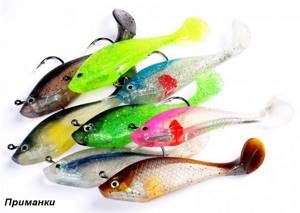
Lures for catching perch
Perch fishing is carried out using spinning baits of all types, but most often spinners, wobblers and silicone baits are used for catching perch.
Spinners

Rotating spoons differ in weight, size, shape and color of the petal.
At shallow depths, back-loaded spinners are used, with a weight of 1 to 8 g, the petal size of which, according to the Mepps classification, is 0-3. For fishing at a depth of 2 meters or more, use front-loaded spinners with a petal number 2-4, guiding the spinner with a stepped retrieve at minimum speed. In sunny weather, baits without glitter are effective, but in cloudy weather it is better to take sparkling ones - silver or golden.
You may be interested in: Spoons for pike
Wobblers

When choosing a wobbler, pay attention to its size and diving depth. The most effective bait is one that goes to the fishing spot near the bottom. The use of deep-sea wobblers with a long blade, going near the bottom, is effective in large bodies of water; for fishing, a floating wobbler is used, throwing it deeper than the fishing point. If a school of perch is located at the surface of the water or in the middle layer, use wobblers with a shallower working depth. The most effective are minnow class wobblers, 5-6 cm in size, the animation of which is created by the spinning player with his play. Brightly colored wobblers are used in muddy water, as well as for fishing at depth. For surface play and in clear water, wobblers of dark and natural colors are more suitable.
Silicone baits
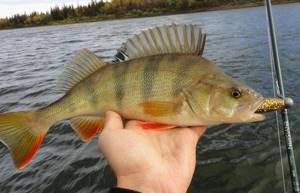
Such baits are made from a material that is more durable, elastic and environmentally friendly compared to rubber. Products come in a variety of shapes, colors and smells, and can be edible or inedible. Advantages of silicone baits:
- They perfectly imitate worms and fry, actively playing in the water;
- Streamlined shapes, keeps them from getting caught on snags and water plants;
- They cost less than wobblers and spinners.
For perch fishing, the dimensions and shape of the bait are important - the characteristics by which a predator chooses a prey. There are two types of silicone baits:
- Active, characterized by pronounced play on a uniform retrieve. These include:
- vibrotail, similar to a small fish (for perch they take it with a tail shaped like a hoof);
- twister with a ribbed oblong body, like a worm, and a tail in the shape of the letter G;
- frog with legs.
2. Passive ones, which play thanks to the actions of the fisherman:
- slug in the shape of a worm, effective when fish have reduced activity;
- fringed frog;
- crustaceans used in thickets and snags.
Recommended sizes:
- 8-10 cm - for catching large perches
- 6-8 cm - for medium-sized perches
- 3-5 cm - for catching small perch
Silicone lures of bright colors are effective in muddy water, and dark colors are effective in transparent water. Aromas that attract perch:
- fish;
- meat;
- garlic;
- shrimps.
Choosing bait for pike
The lure rating is as follows:
- oscillating spoons - they have good flight qualities and are suitable for fishing from the shore with long casting. Heavy models are used in deep waters, and light ones in shallow waters.
- Rotating spoons - use large spinners ranging in size from 3 to 6. They attract toothy predators better than spinners, but they fly close.
- Silicone baits - twisters and vibrotails with a length of 5 to 15 cm are more often used.
- Wobblers - the best results come from minnow-type models designed for jerking retrieves.
- Poppers - models with a length of 7 to 12 cm are best.
Pike
The main desired object of fishing for a spinning angler is pike. It is this predator that reaches impressive sizes, and even in a small river you can count on catching a large “mother” who has come here to spawn.
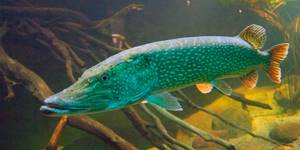
For wobblers
Small rivers are excellent for catching pike with wobblers. Long casting is not required here, and you can skillfully cast the bait from a short distance under any snag, which abound in small rivers. To do this, it is better to use floating “Floating” wobblers of the “Minnow” or “Suspending” , which have neutral buoyancy and hover in the water column during pauses. With pop-up wobblers you can catch small snags, behind which the predator most often lies in ambush. By stopping the bait at the obstacle for a few seconds, we achieve the ascent, thereby bypassing the hook. polarized glasses when fishing , which allow you to see objects under water much better and better control the wiring of the wobbler. It is very interesting to watch how a pike comes out from behind cover and attacks your bait. Perhaps this is one of the most exciting fishing trips that brings a lot of emotions and adrenaline.
Typically, wobblers from 7 to 12 cm long with a depth of 15 cm to 1.5 are used for pike. It’s not worth getting smaller - after spawning, the predator willingly feeds and rushes to bait, barely 2 times smaller than its own height. They use 2 types of basic colors - natural fish colors, and acidic ones - orange, bright green, red. Depending on the illumination and turbidity of the water, the fisherman must experiment to determine the preferences of the predator and identify a pattern. Although some anglers argue that the pike does not care about color, and it is better to simply choose bright wobblers that are better visible from far under water, in order to make it easier to control the retrieve. I don’t dare to argue with this; everyone can check this statement from their own experience.
In this video we give general tips on choosing wobblers for pike, perch and pike perch in early summer.
The main wiring method is twitching . Now, with the warming and brightening of the water, when the pike becomes more aggressive, this active method of presenting bait will be the most effective. The classic “Stop and go” also gives good results, especially during a pause, when hovering and ascending, avoiding snags and boulders at the bottom. Sometimes the fish may be in a stupor due to weather conditions. It is the long pause and rocking of the wobbler from side to side during the ascent that provokes the pike to attack in this state.
A variety of wobblers include poppers , although this is more of a perch bait, pike can also be successfully caught with it. This attraction is accompanied by bright moments - frequent misses and noisy splashes. Cool fishing! Use a popper in places where the bottom is so tightly covered with snags that even offset and foam rubber cannot pass through - here the popper will give you the only chance to stay with the bait and lure a worthy specimen out of the windfall itself.
Unloaded silicone
Silicone lures have always been a favorite when fishing for pike. Usually small rivers do not have significant depths and are extensively overgrown with algae and grass. Where the wobbler will not pass, twisters and vibrating tails equipped with an offset hook come to the rescue. If you use large enough baits, then their weight is quite enough to make an accurate cast and fish the main water horizons. On the current, and in deeper places, it would be wise to lightly weight such a bait. Unloaded rubber is carried out with a slight smooth twitching with pauses, very similar to twitching a wobbler. A standard jig step is also always in place.
For pike fishing, we always use a string leader , or a thick leader material of about 0.5 mm. from fluorocarbon .
Rotating and oscillating spoons
This type of bait must be in the arsenal of a pike hunter, especially on small rivers! Whether to focus on them or not is an amateur question. But it is the vibrations and vibrations of the “iron” that are sometimes all that the fish need. Pike can ignore silicone, even wobblers, and rush to the rotating petal, especially in muddy water, focusing its lateral line on its powerful vibrations.
Equipped with tees, these spoons are very vulnerable to snags, which abound in small rivers. There are different ways to protect your hook and reduce wastage. This includes equipping with “non-snacking” mustaches and replacing the tee with an offset hook equipped with silicone. There are many ways you can find out online. If you focus on iron fishing, you should know how to take care of hook protection.
Here I will give specific recommendations for beginners. Pay attention to branded spinners from Maps and BlueFox , models Vibrax, Aglia Long, Black Fury, Cyclops and others - these are long-proven, win-win options to try the hardware and not be left without a catch.
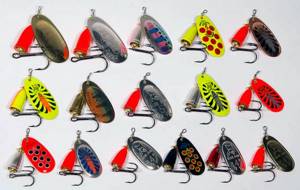
Foam rubber fish
Perhaps I’ll stop my story at this type of bait. They are perfect when it comes to catching pike in snags. And what small river is deprived of it? Although foam rubber is not the main argument in your arsenal, along with rotating spoons, this is the type of bait that can pull out your hopeless fishing and help you get away from zero when wobblers and silicone are silent. In addition, equipped with doubles, they detect fish well, and pass snags and rubble perfectly.
There are many types of unhooked ones. You can make an interesting option with your own hands, according to the instructions from the article by our user Alexey aka Bezrukov .
When to catch
Pike and perch remain active all year round.
Spring
At the beginning of spring, after rivers and lakes are free of ice, when the water is still cold, you need to look for fish at depth. As summer approaches, pike and perch increasingly come out to feed in shallow waters warmed by the sun. By the end of spring, these predators gradually switch to summer mode.
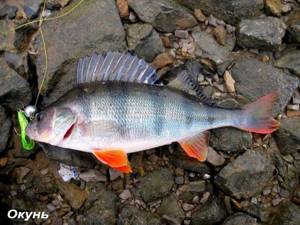
Summer
In summer, small pike and perch feed under the shore, and large specimens hunt at depth on edges and holes, as well as in snags.
Winter
In winter, you can successfully catch pike and perch in bodies of water that are not covered with ice. You need to look for fish at depth and use slow retrieves, which allow you to tempt a predator that is passive in cold water to bite.
Autumn
At the beginning of autumn, pike and perch hunt both near the shore and at a distance from it. As freeze-up approaches, they gradually go deeper. In the second half of autumn, the predator begins to actively feed in order to gain fat for the winter - this is the best time for catching pike and perch.
Pike fishing by time of year
Pike feeds all year round, so you can catch it all year round, but the degree of activity of pike changes throughout the year. The fisherman must take into account the activity of pike when choosing the method and tactics of catching it. Experienced anglers have success catching pike throughout the year, but it is best for beginners to begin fishing for pike during periods of peak activity.
Spring
In spring, there are two good periods for pike fishing. The first period is the pre-spawning zhor, which begins with the melting of ice, about a week before spawning and ends with the beginning of spawning. During the pre-spawning period, pike can be caught well by all means, both with live bait and with artificial baits.
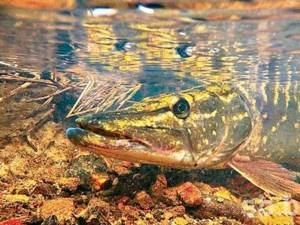
During spawning, which occurs in March and lasts about two to three weeks, pike are not at all interested in food and therefore are practically not caught. After the end of spawning, the pike gradually regains its strength and the post-spawning feast begins, which lasts until May. Two to three weeks of the post-spawning period are the best time for pike fishing in the spring.
Summer
High water temperatures in summer have a bad effect on the well-being and activity of pike. Late June-July, the hottest summer months, is a bad time for pike fishing. At this time, pikes leave shallow areas of reservoirs for deeper ones, preferring to stay in hard-to-reach places: thickets, snags and holes.

Due to the abundance, availability and diversity of the food supply, in the summer pike becomes extremely picky about food. The success of pike fishing at this time of year depends on the angler’s ability to choose the right bait that will provoke the pike to bite.
Autumn
Autumn, from September to early November, is the best time for pike fishing in open water. The autumn cooling of the water tells the pike that winter is coming. Without the necessary supply of energy, she will not be able to survive the long and harsh winter. The pike begins to hunt more intensively, its feeding trips become more frequent and longer. In autumn, pike leave their summer camps and begin to move more actively around the reservoir.
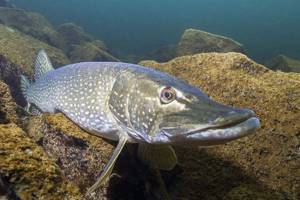
In autumn, the pike bite sometimes lasts the entire daylight hours with short breaks. Pike are best caught in the fall using a spinning rod, but other fishing methods can also be very effective. Cloudy days with small ripples on the surface of the water are ideal weather conditions for pike fishing.
Winter
Pike can be caught all winter, but the best fishing periods are the first and last ice. As soon as ice is established on the reservoirs, the winter feeding of pike begins, which fishermen call the first ice. This is the best time for pike fishing in winter, this period lasts from one to three weeks. After this, the activity of the pike gradually decreases and a lull sets in, which fishermen call the wilderness.
You may be interested in: Twister
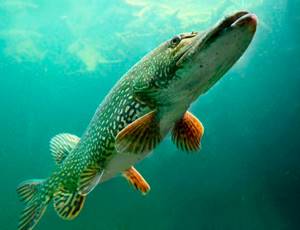
In the dead of winter, fishing for pike in still waters does not make sense. At this time, it is much more effective to catch pike on the river, where the water is more enriched with oxygen and the pike is more active.
Towards the end of winter, with the arrival of spring thaws, before the ice breaks up in the reservoirs, the pike becomes active again, and soon the pre-spawning pike feast begins.
Lures for catching pike and perch in autumn
In the fall you can count on excellent catches of pike and perch, but it is important to know how to choose bait for hunting these predators.
Silicone
Twisters, vibrotails and other silicone baits mounted on a jig head or on a rig with a Cheburashka sinker are well suited for catching pike and perch on a spinning rod in the fall at depth. Large size models work in the fall.
Wobblers
Wobblers can be used throughout the fall. Models with a slight depth are suitable for fishing in the coastal zone, and deep-sea ones are suitable for hunting predators far from the shore. Throughout the fall, minnow wobblers with twitching wiring work well for perch and pike.
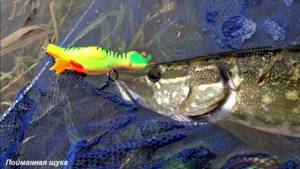
Poppers
Popper is a good bait for perch and pike in the first half of autumn, when the fish often feed in shallow waters. As winter approaches, the predator goes deeper and it loses its relevance.
For trolling
Autumn is the best time to hunt for trophy pike. Excellent results can be achieved using trolling. For such fishing, oscillating spoons, silicone and wobblers are used. A pike spinning rod for this kind of fishing can be of any length, the throwing qualities of the gear do not matter, the main thing is that its test was not too small.
Jig lures
In addition to silicone baits for catching pike and perch with jigs in the fall, you can use wabiki and foam fish. The latter are well suited for hunting trophy specimens.
Choice of spinners
For fishing in shallow waters in the first half of autumn, you need to use light spinners and spoons. Throughout the autumn season, in the depths you can catch pike and perch using weighted spinners and heavy spoons. Thus, having assembled a set of spinners, you can fish with these spinning baits in any conditions throughout the fall.
Turntables
For fishing in the fall, the same spinners that are used in spring and summer are suitable, but you should choose larger models - 1-2 sizes larger.
Pike fishing in open water
There are several ways to catch pike during the open water season. Pike can be caught with a spinning rod, with a float rod, with live bait, with a donka, with summer baits and with mugs.
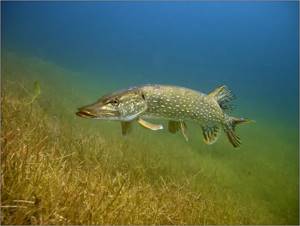
Some of these methods require the presence of a boat, others can be carried out both from a boat and from the shore. Each angler chooses for himself the method that suits him best based on the conditions in which he has to fish, the availability of certain fishing gear, and his personal preferences in fishing.
Spinning
Pike fishing with a spinning rod is the youngest, and at the same time, the most popular way of catching this predatory fish. The principle of spinning fishing is to cast the bait using a rod and then retrieve it by rotating the reel and moving the rod.
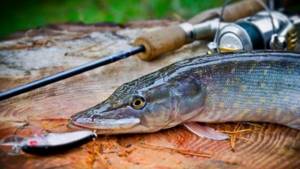
Fishing for pike with a spinning rod involves constantly moving the angler around the reservoir to search for active pike, changing baits and constantly experimenting with a variety of fishing rods. You can catch pike with a spinning rod throughout the open water season, from early spring to late autumn, with the exception of the time of spawning ban. Fishing for pike with a spinning rod can be done both from the shore and from a boat, but as a rule, a boat greatly expands the angler’s capabilities.
For pike fishing, a spinning rod is used, equipped with a spinning reel on which a cord is wound, to which an artificial bait is attached through a leash. Pike fishing with spinning rods can be done both from the shore and from a boat. To catch pike from the shore, use a rod with a length of 2.7 m, and when fishing from a boat it is easier to use a shorter rod with a length of 2.1-2.4 meters.
The diameter of the fishing line (cord) is selected taking into account the expected size of the prey. For pike fishing, both braided lines and monofilaments are used.
When fishing for pike, you must use a leash, the function of which is to protect the fishing line from the sharp teeth of the pike. The leash is most often made of Kevlar, titanium, tungsten or guitar string. Some fishermen use fluorocarbon leashes when fishing for pike; they are almost completely invisible in the water, but are less resistant to pike teeth than metal leashes.
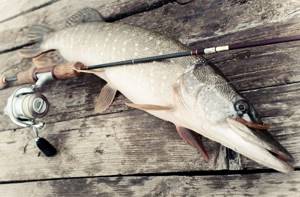
A wide variety of spinning lures are used for pike fishing:
Oscillating spinners -
one of the oldest spinning baits. They are a metal plate curved in the longitudinal or transverse direction, in the tail part of which a tee is fixed. When moving in the water, the oscillating spoon moves from side to side, rolls from side to side or trembles slightly, creating vibrations of a certain amplitude and frequency that attract predatory fish. Oscillating spoons are used for catching pike both in still water and in the current. Oscillating spoons are quite versatile, easy to use and inexpensive, which is why they are very popular among anglers.
Spinners
easy to use and catchy, most beginning spinners begin their journey in spinning by fishing with spinners. Spinner baits consist of a wire rod on which is attached a metal petal and a treble hook. When the spoon moves in the water, during the retrieve, the petal rotates around the rod, creating high-frequency vibrations and glare in the water that attract predators. Rotating spoons have numbers that indicate the size of the blade of the spoon, spoons come in sizes from 00 to 6. For catching small and medium-sized pike, rotating spoons numbered 2 and 3 are well suited; for catching large pikes, spinners numbered 4 to 6 are used.
Silicone baits
are a very popular class of lures for pike fishing. Silicone baits come in a wide variety of shapes and types, the most common among them: twisters, vibrotails, worms, octopuses, crustaceans, frogs. Many types of silicone baits resemble in their appearance real food items of predatory fish, others are completely fantasy. Silicone baits are divided into edible and inedible; attractants are added to edible baits, which additionally attract fish with their smell and taste. Silicone baits are available in a large number of different colors. For fishing, silicone baits are mounted on a jig head or on an offset hook connected to an eared sinker (Cheburashka). Lately, fishing with spaced-out rigs has become increasingly popular among spinning anglers: retractable leash, drop-shot, Carolina and Texas rigs. The method of fishing with silicone baits is called jig.
You may be interested in: Som
Wobblers
are solid baits, their appearance resembling fry and intended for catching predatory fish. Wobblers can be of different sizes. To catch large pike, you can use wobblers with a length of 100 mm and above. For catching medium-sized pike, wobblers 7-10 cm long are suitable. Wobblers vary in shape, each of which has its own name: minnow, shad, crank, fat and others. Good results when fishing for pike are shown by minnow wobblers, which are carried out with a special jerking retrieve called twitching. Other types of wobblers show good results: shads, poppers, cranks. Wobblers vary in the degree of buoyancy; they are: floating, suspended and sinking. Wobblers also vary in depth, they can be: surface, subsurface, shallow, deep, ultra-deep. Depending on the fishing conditions, the angler selects a wobbler that is suitable in terms of its parameters and characteristics.
Live bait fishing rod
Many anglers catch pike on a float rod with live bait attached to a hook. To catch pike with a fishing rod, anglers use a long telescopic rod, which allows them to cast into windows of clear water. An inertial or spinning reel is installed on the fishing rod; most anglers use a spinning reel, which is much easier to use.
A leash must be installed between the fishing line and the hook, which can be metal, Kevlar, titanium, tungsten, guitar string or fluorocarbon fishing line. Fluorocarbon leashes are less noticeable in the water, but less resistant to pike teeth than metal leashes.
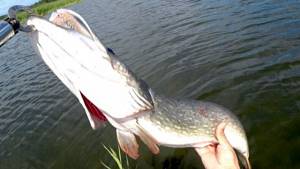
The float must be special for fishing with live bait; it is barrel-shaped and has a large carrying capacity so that the live bait cannot drown it. The float must be loaded up to the antenna. You can buy a float at a fishing store or make it yourself from a champagne cork. The float should be visible at a distance of up to 20 meters. The hooks used are relatively small; they can be triple, double or single.
When choosing live bait, you should take into account the degree of its survivability; pike prefers live and active fish; it most often ignores dead ones. Good bait for live bait: small crucian carp, carp, gudgeon, roach. It is best to catch live bait in the same body of water where fishing will take place; pike are more willing to catch food that is familiar to it. If there are a lot of frogs in the body of water where you are fishing for pike, they are most likely a frequent prey for pike, so fishing for a frog will most likely be successful. Live bait must be released into the water.
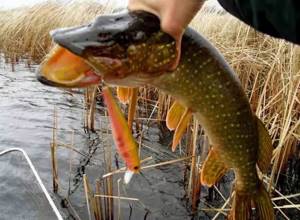
Fishing for pike with a live bait rod is most effective in the summer on small rivers with gentle currents and heavily overgrown reservoirs with standing water. It is better to catch pike with a live bait rod from a boat in order to increase the number of places fished.
After casting live bait, the fisherman waits five to seven minutes; if during this time there is no bite, he should move to another place. The fisherman can periodically return and re-fish old fishing spots that have already been fished.
Bottom fishing rod
A bottom fishing rod is not the best tackle for catching pike. In summer, pike stay in thickets of underwater vegetation, in snags. In such places there is no opportunity to perform a normal cast and to land the caught pike on the bottom tackle.
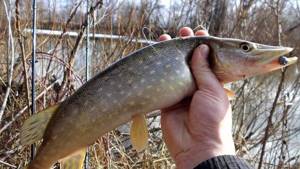
Many anglers successfully catch pike using bottom tackle in water bodies that are clear of underwater vegetation and snags. At the same time, they use both a classic donk and a donk with a rubber shock absorber. The best time for such fishing is spring, when the underwater vegetation has not yet had time to grow, and late autumn, when the bulk of the underwater vegetation has already died off. You can cast bottom gear along the shallows where pike come out to feed. You can use live bait or a frog as bait. Pike of all sizes are caught with live bait, and, as a rule, the largest individuals are caught with frogs.
If you choose between a classic donka and bottom tackle with a rubber shock absorber, then you should give preference to rubber, which does not require the use of a boat for repeated casts and creates much less noise that scares away pikes.
Catching pike with summer baits
The supply rig is the oldest equipment for catching pikes. The zherlitsa has an extremely simple device. You can fish with a zherlitsa on a pond, lake or small river. Grills are installed in places where pike often hunt for small fish: in windows among aquatic vegetation, under trees overhanging the water, next to flooded bushes.
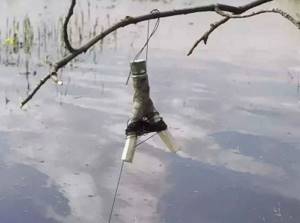
The zherlitsa consists of:
- A reel, which can be made from a wooden flyer with splits at the ends, from a plank, plywood or even a plastic bottle.
- Fishing line of sufficient strength, wound on a reel, at least 7 meters long
- A lead sinker, which is needed to hold live bait so that it does not go into the grass
- Fluorocarbon leader tied to the fishing line via a swivel
- Hook, quite large in size, which can be triple, double or single
Live bait is attached to the hook of the girder and the tackle is thrown into the water. The best live bait for catching pike in summer: bleak, dace, perch, roach, gudgeon. The fishing line is inserted into the split of the flyer in such a way that when the pike takes the bait, the fishing line is released from the split, and later, when the fishing line finishes unwinding, the pike will hook itself. The reel is tied to a tree and a pole driven on the shore or in the water.
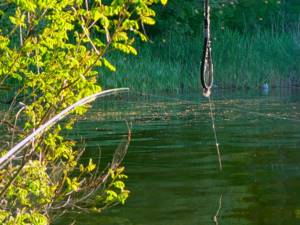
Anglers who fish with girders install several girders in the most promising places in the reservoir, and, as a rule, leave them overnight. In the morning, fishermen go around the girders one by one and check them.
Fishing with mugs
A circle is a floating version of a summer vent. The circle is a foam float in the form of a disk, which has a groove for winding fishing line at the end. Different sides of the disk are painted in different colors, usually white and red. When a pike grabs a live bait, the circle turns over with its bright side up, alerting the angler to a bite.
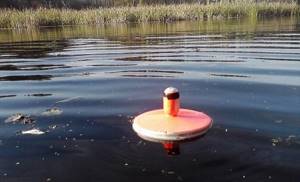
There are two ways to catch pike with mugs. The first method is used on calm rivers and lakes; mugs with attached hooks are allowed to float freely. The mugs slowly float through the water, under the influence of the current and the force of the wind, and look for the pike themselves. The second method of fishing with circles is to secure the circles in one place using a fishing line with a sinker attached to it. In this case, the mugs are placed near snags, next to thickets of grass, that is, in those places where actively feeding pike often hang out.

Pike fishing with mugs is done from a boat. In order to catch the maximum area of the reservoir, the mugs are installed or floated in a checkerboard pattern. The mugs must be within the angler’s visibility at all times so that he can react to pike bites.
It is best to use live bait taken from the same reservoir where pike fishing will be carried out for baiting mugs. Live bait is placed at half-water or forty centimeters from the bottom. During the fishing process, the fishing horizon is changed, depending on which horizon the bites most often occur on.
You may be interested in: Kosadaka Wobblers
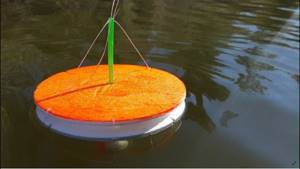
The fisherman must constantly monitor the circles and as soon as one of them is triggered, he slowly and carefully, trying not to scare off the pike that took it, swims up to the triggered circle. The fisherman carefully collects the line into the boat, and as soon as he feels the heaviness, he makes a hook and begins to fish out the caught pike. Pike are caught in circles throughout the open water season, but the best time for this method of pike fishing is September-October, the time of the autumn pike feeding season.
Some fishing secrets
Pike can live in small ponds that are densely overgrown with grass in the summer. Many fans of spinning fishing, looking at these “puddles”, cannot even imagine that there are fish in them. Meanwhile, toothy predators can be successfully caught in them using spoons and silicone. Therefore, such reservoirs should not be avoided.
Light baits are used here. But the tackle must have increased power; it will allow you to tear out trophies that have sat on the hook from strong places and free the bait from snags.
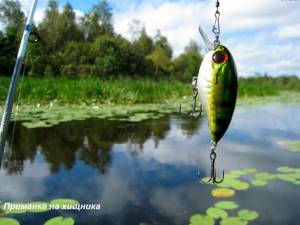
In an arsenal designed for pike fishing, there must be suspender baits that have neutral buoyancy. During wiring, you need to take pauses when the bait hangs in the water column. This technique perfectly provokes pike to bite.
Perch loves red. Therefore, to catch it, it is preferable to choose baits that are colored accordingly.
Fishing for pike and perch may seem simple at first glance, but in fact there are many nuances to it. To achieve success, the first thing you need to do is choose the right spinning rod. With high-quality gear, fishing will be comfortable, and the chances of ending up with a good catch will be maximum.

